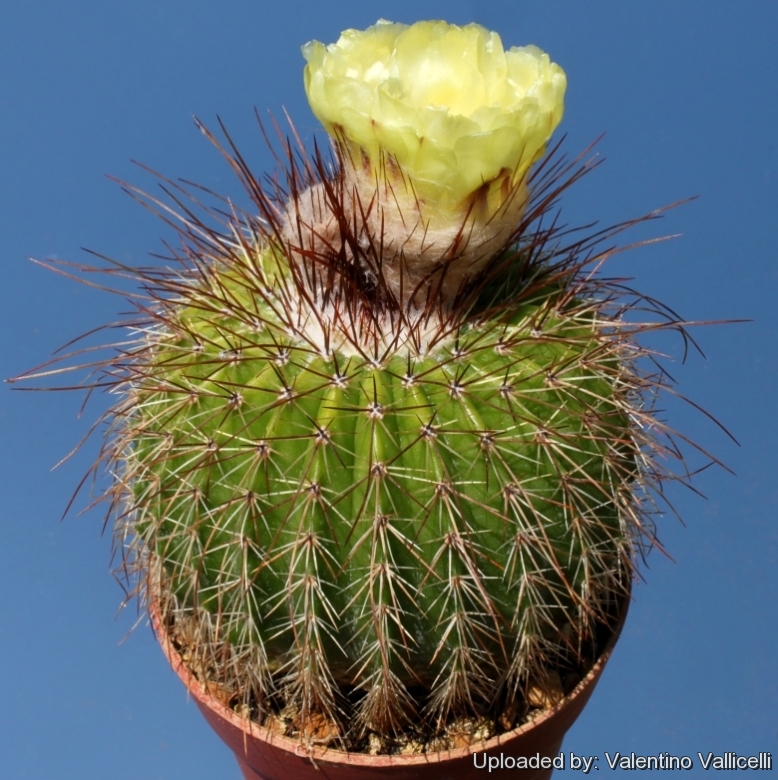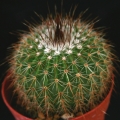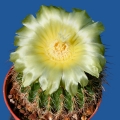
Parodia nigrispina Photo by: Valentino Vallicelli
Origin and Habitat: Parodia nigrispinaSN|1152]]SN|1152]] is endemic to the Cordillera department of Paraguay (near Paraguarí, between Carapegua and Acahay). This species has a restricted and severely fragmented range (extent of occurrence is 3,000 km2) and is under pressure due to illegal collection for local commercialization. Local extinctions have already occurred.
Altitude range: It occurs at elevations between 100 and 400 metres above sea level.
Habitat and ecology: This species grows on rocky outcrops in open areas of selva paranaense on a flat plateau of sandstone among moss and lichens because of the high humidity of this area. It is often found growing together with Tillandsias, Dyckia tobatiensisSN|34177]]SN|34177]], sparce shrubs, grasses and in one case with Gymnocalycium fleischerianumSN|17574]]SN|17574]]. Parodia nigrispinaSN|1152]]SN|1152]] grows in the thin soil covering containing sand from the decomposition of the rocks and relatively much humus from the decomposition of the Bromelia roots. It is often found growing in very hard and impenetrable termite nests, and has a well developed lateral root system. The major threat for this cactus is collection for commercialization.
Synonyms:
Description: Parodia nigrispinaSN|1141]]SN|1152]] is a very spiny cactus specie forming more or less compact clusters with age. This plant is often synonymized with Parodia schumannianaSN|1152]]SN|1141]], but it has wider and lower growing body, darker brownish-black spines and comes from a totally different type of habitat.
Habit: Plants solitary but at times forming small clusters by basal branching.
Stems: Up to 40 cm tall and 16 cm broad, globose to short-columnar, green.
Ribs: 20 or more, rather acute, 20-25 mm apart.
Areoles: Circular to oval, 2 mm in diameter, with much white wool in youth and eventually becoming bare.
Spines: 9 or 10, acicular, thin, not clearly differentiated as centrals and radials 25-60 mm long, dull white to reddish, of which 3-4 longer and darker brownish somewhat curved, slender, often blackish when young, afterwards silvery.
Flowers: up to 6,5 cm long and 7 cm in diameter, yellow, funnelform; scales of the ovary filled with hairs and bristles.
Fruits: Globular about 1,5 cm in diameter, shiny brown.
Bibliography: Major references and further lectures
1) Edward Anderson “The Cactus family” Timber Press, Incorporated, 2001
2) James Cullen, Sabina G. Knees, H. Suzanne Cubey "The European Garden Flora Flowering Plants: A Manual for the Identification of Plants Cultivated in Europe, Both Out-of-Doors and Under Glass" Cambridge University Press, 11/Aug/2011
3) David R Hunt; Nigel P Taylor; Graham Charles; International Cactaceae Systematics Group. "The New Cactus Lexicon" dh books, 2006
4) Franz Buxbaum “Morphology of cacti”, Volume 1 Abbey Garden Press, 1950
5) Nathaniel Lord Britton, Joseph Nelson Rose “Cactaceae: Descriptions and Illustrations of Plants of the Cactus Family” Courier Dover Publications, 1963
6) Pin, A. & Kiesling, R. 2013. Parodia nigrispina. The IUCN Red List of Threatened Species 2013: e.T151745A556878. http://dx.doi.org/10.2305/IUCN.UK.2013-1.RLTS.T151745A556878.en. Downloaded on 17 July 2016.
7) Pin, A.B. and Simon, J. "Guía ilustrada de los Cactus del Paraguay". SEAM/GReB, Asunción. 2004.
 Notocactus nigrispinus (Parodia nigrispina), Chololó, Cordillera, Paraguay. Photo by: Alexander Arzberger
Notocactus nigrispinus (Parodia nigrispina), Chololó, Cordillera, Paraguay. Photo by: Alexander Arzberger Parodia nigrispina Photo by: Alexander Arzberger
Parodia nigrispina Photo by: Alexander Arzberger Parodia nigrispina Photo by: Valentino Vallicelli
Parodia nigrispina Photo by: Valentino Vallicelli Parodia nigrispina Photo by: Valentino Vallicelli
Parodia nigrispina Photo by: Valentino Vallicelli Parodia nigrispina Photo by: Valentino Vallicelli
Parodia nigrispina Photo by: Valentino Vallicelli Parodia nigrispina Photo by: Valentino Vallicelli
Parodia nigrispina Photo by: Valentino Vallicelli In habitat. Photo by: Alexander Arzberger
In habitat. Photo by: Alexander Arzberger Parodia nigrispina Photo by: Valentino Vallicelli
Parodia nigrispina Photo by: Valentino VallicelliCultivation and Propagation: It is not the easiest species to cultivate as it grows in a humid area where a really dry season doesn't exist.
Soil: The soil should be very well drained, with sand and organic matter, and never should stay too dry.
Pots: It needs a relatively shallow pot to accommodate its fibrous roots and provide a very good drainage. It may stay in the same pot for many years.
Watering: Water regularly in summer, it prefer a drier place during winter, but some light waterings are needed in winter too. Water it less than average if in bigger pots.
Special need: Provide very good ventilation. Nearly all problems occur as a result of overwatering and poor ventilation, especially when weather conditions are dull and cool or very humid.
Fertilization: Feed them once during the growing season with a fertilizer specifically formulated for cactus and succulents (high potash fertilizer with a dilute low nitrogen), including all micro nutrients and trace elements diluted to ½ the strength recommended on the label. They thrive in poor soils and need a limited supplies of fertilizer to avoid the plants developing excess vegetation, which is easily attacked by fungal diseases.
Exposure: It will do its best with lots of sun and become stressed with inadequate light which could result in poor growth and unnatural shape.
Hardiness: It likes warmth (recommended minimum winter temperature 5° C) for safe cultivation it is best to avoid freezing temperatures. In summer, it likes to be kept very warm and humid (especially with high air humidity at night).
Use: This is a good pot plant suited for a non heated green house. It can be also cultivated outdoors in raised beds, terraces if sheltered from winter rain. This cactus continues to be, a particular prize among collectors
Pests & diseases: These cacti may be attractive to a variety of insects, but plants in good condition should be nearly pest-free, particularly if they are grown in a mineral potting-mix, with good exposure and ventilation. Nonetheless, there are several pests to watch for:
- Red spiders: Red spiders may be effectively rubbed up by misting the plants from above.
- Mealy bugs: Mealy bugs occasionally they develop aerial into the new leaves and flowers with disfiguring results, but the worst types develop underground on the roots and are invisible except by their effects.
- Rot: Rot is only a minor problem if the plants are watered and “aired” correctly. If they are not, fungicides won't help all that much.
Propagation: The propagation with seeds is easy, but they grow a little slow.. The seeds can be sown in pots of fine, well-drained sandy soil, any time during the spring when temperatures are warm. Cover the seeds with a fine layer of grit and water from below with a fungicide to prevent damping off. For the 1-2 weeks cover the pots with a sheet of glass/clear perspex to keep the humidity levels high. Remove the glass and replace it with light shade-cloth and mist once or twice a day for the next two weeks after which most seeds should have germinated. From then on mistings can be reduced to every second and then every third day as the little plants grow.
Your Photos

by Valentino Vallicelli

by Valentino Vallicelli




















